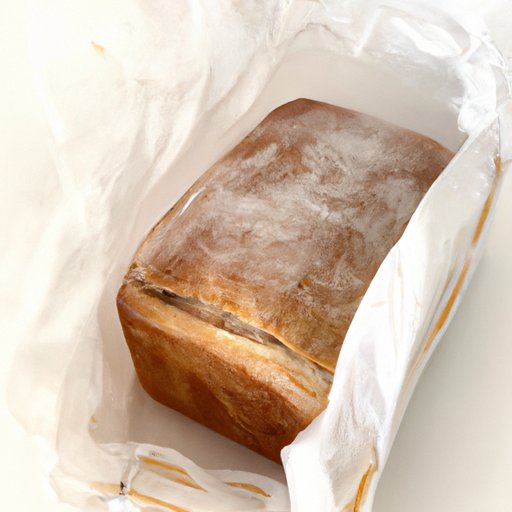
Introduction
Do you often find yourself throwing away stale bread? Or do you have trouble finding the time to go to the bakery for fresh bread every day? Freezing bread is a fantastic solution to both problems! Not only does it allow you to prolong the life of your bread, but it also gives you access to fresh bread without having to leave your home. In this ultimate guide, we will walk you through the best tips and tricks for freezing all types of bread, from store-bought bread to homemade dough.
The Ultimate Guide to Freezing Bread: Tips and Tricks for Perfect Preservation
Freezing bread is an excellent way to ensure that you always have fresh bread on hand. Not all bread freezes well, so it’s important to choose the right type of bread. Generally, bread that is high in moisture, such as sourdough or ciabatta, does not freeze well. Bread that is lower in moisture, such as sliced bread, baguettes, and rolls, can be frozen with great success.
When it comes to preparing bread for freezing, it’s important to wrap it tightly in plastic wrap or aluminum foil. The goal is to protect the bread from freezer burn, which can make the bread taste stale or freezer-burned. Another great tip for freezing bread is to slice it before freezing. This way, you can take out only the slices you need at any given time, rather than having to thaw the whole loaf.
There are a variety of storage methods you can use for frozen bread. Airtight containers or freezer bags work well. Be sure to label the container or bag with the date the bread was frozen, so you can keep track of how long the bread has been in the freezer. When it comes time to thaw the bread, be sure to do it properly. The best way to thaw bread is to take it out of the freezer and let it sit at room temperature until it is completely thawed. Alternatively, you can put it in the fridge overnight to thaw it slowly. Avoid using the microwave to thaw bread as it can make the bread rubbery.
If the bread seems stale after thawing, there are a few tricks you can use to revive it. Try sprinkling water on the bread and reheating it in the oven for a few minutes. This can help to restore the moisture in the bread and give it a fresh taste.
DIY Frozen Dough: How to Stock Your Freezer with Homemade Bread
One of the best things about freezing bread dough is that you can have fresh bread any time you want it! Making dough is easy and can be done in large batches. Pizza dough and bread dough are easy-to-freeze doughs that work well. Simply mix up a batch of dough, knead it, and put it in a plastic bag to freeze. When it’s time to bake, take the dough out of the freezer and let it thaw in the fridge overnight. The next day, let the dough come to room temperature and rise before baking.
The Benefits of Freezing Bread: Saving Money, Reducing Waste, and More
Freezing bread can save you money and reduce food waste. Buying bread in bulk and freezing it means that you always have bread on hand, without having to make frequent trips to the bakery. It also means that you can take advantage of sales and discounts when they’re available. Additionally, freezing bread can reduce food waste as it allows you to preserve bread that may have otherwise gone stale and been thrown away. This means that less food goes to waste and less carbon emissions are produced as a result.
When it comes to reducing waste, it’s important to consider how much bread you actually need. If you are only going to eat a portion of a loaf, consider slicing it up before freezing it. This way, you can take out only the slices you need and avoid having to throw away the rest.
Making Breakfast a Breeze: Freezing Your Favorite Breakfast Breads
Freezing breakfast bread is another fantastic way to have a delicious breakfast with minimal effort. Muffins and scones are easy-to-freeze breakfast breads that work well. Simply make a batch, let them cool, and put them in a freezer bag. When you’re ready to eat, take them out of the freezer and let them thaw at room temperature for a few hours. If you’re in a rush, you can microwave them for a few seconds to warm them up.
From the Bakery to Your Freezer: How to Freeze Store-Bought Bread
When it comes to freezing store-bought bread, it’s important to consider the type of bread you’re freezing. Generally, bread that is lower in moisture, such as sliced bread, baguettes, and rolls, can be frozen with great success. When you bring home store-bought bread, freeze it as soon as possible to limit the damage caused by thawing and refreezing.
To reheat store-bought bread, simply put it in the oven for a few minutes to warm it up. If it seems stale, try sprinkling some water on the bread and heating it in the oven. This can help to restore the moisture and freshness of the bread.
Conclusion
Freezing bread is a fantastic way to ensure that you always have fresh bread on hand. From store-bought bread to homemade doughs, there are many types of bread that freeze well. By following a few simple tips and tricks, you can ensure that your frozen bread remains fresh and delicious. Whether you’re looking to save money, reduce waste, or simply have fresh bread whenever you want it, freezing bread is the perfect solution.




